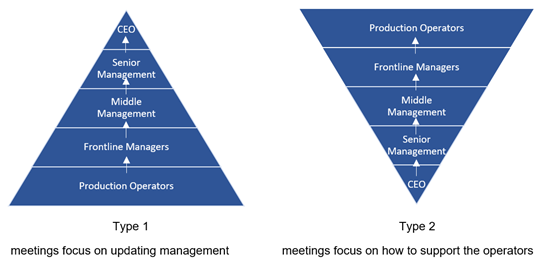Whether it’s a quick huddle at the start of the shift between the supervisor and production operators or a top level review with the operations management team, manufacturing meetings can be effective in just 5 minutes
6 min read

When it comes to meetings, they are often seen as a necessary evil, and that’s no different in manufacturing. Any of these sound familiar?
- “We spend all morning talking about yesterday”
- “There is no clear structure”
- “We’re always going off on a tangent”
- “The meeting never starts or finishes on time”
- “Let’s not flag that issue – the managers will flip!”
There are some tips and tricks that can help turn meetings into a powerful tool to get everybody aligned and motivated. Here are a few of our tried and tested techniques…
1. Set the right tone
Set a positive tone that encourages team engagement…
- Focus on the positives: Nothing ever goes perfectly well. Pick out the positives even when mistakes are made. This will avoid deflating the team
- See problems and mistakes as opportunities: If the reaction to problems is to throw the toys out of the pram, don’t be surprised if a culture of cover up is created. Encourage the team to identify problems and see them as opportunities to improve
- Encourage data-based decision making: “This always happens” or “that never happens” are common reactions to problems. Insist on making decisions based on data and look for the right data if none exists. Kt-Pulse is a great way to capture and present manufacturing performance data from any manual or semi-automated process
- Switch the mindset of who serves who: If you’re a type 1 organisation (see figure below), try the gradual shift towards type 2. Type 2 organisations put their energy into helping the frontline workers in whatever way they can, bringing new levels of productivity and efficiency.

2. Set an agenda with clear objectives
If your team turns up at a meeting without a clear purpose, it will be of limited value. To make the most out of the meeting, here’s a few pointers…
- Make the overall objective very clear and visible, particularly for daily meetings (e.g. the objective of the meeting is to identify the priority actions for the day, in order to hit our planned output)
- Create a small set of questions (preferably 5 or less) that are asked every day and that are linked to the overall objective (e.g. are there any issues that are likely to prevent us from hitting our output plan today?). Time spent doing this properly can save an abundance of wasted time on poor meetings.
- Define who should attend and what their role is at the meeting and ensure that every question has an owner
3. Start on time
This is a no-brainer but very important. If the senior person at the meeting is routinely late, it creates a mindset that their time is more important than everybody else’s time…
- Set a good example by being on time, particularly if you are one of the senior attendees
- If there are back-to-back meetings, allow time to travel to the next meeting
- Everybody is late sometimes. If so, apologise and don’t make it a habit
- Start the meeting without latecomers. Try out a charity jar; €1 for each late arrival!
4. Be dynamic
Manufacturing meetings are best run on the shop floor. They are dynamic environments, much like the meeting should be. Here’s how you can make your meeting dynamic…
- Keep it short – maximum 10 minutes, preferably 5
- Stand-up meetings are best; around a screen or whiteboard
- Mix up who runs the meeting to keep everybody aligned on the format
- Be open to changing the format if it’s not achieving the meeting objectives
- Avoid getting into deep discussions. Factor in time for spinout conversations in smaller groups
5. Keep the language simple
Talking in acronyms might make it seem like you’re very knowledgeable but don’t assume everybody understands them…
- Keep the language simple and minimise jargon so that nobody feels overwhelmed or left out
- Avoid high tech language. As Albert Einstein once said, “If you can’t explain it simply, you don’t understand it well enough.”
6. Finishing up
Starting and finishing meetings on time take discipline. And finishing on time with clear actions for the day ahead is a great sign of a well-run meeting…
- Finishing on time might mean stopping the meeting in the middle of a conversation, but that sends a powerful signal that it’s not okay to run over. Nominating a timekeeper might help
- Leave the meeting with clear expectations for the day. For daily meetings, focus mainly on the next 24 hours. If a task takes several days to complete, break it into subtasks for the daily meeting
- Highlight where support is needed from peers and managers in order to get things done
- Get into the habit of assigning an owner and target date for every task
- Put an escalation process in place so that everybody knows whom to flag if support is needed
- Take issues and discussions offline, with the relevant people
- Aim to finish the meeting on a positive note every time
Request a free demo
If you’d like to see for yourself how Kyzentree’s software, Kt-Pulse, can help you to monitor and improve your manual processes, book a one-to-one, no obligation consultation today and we’ll showcase the benefits to you

Anthony Cahill has over twenty years’ experience in various roles within the manufacturing sector. He has primarily worked in manufacturing operations that rely on people working with their hands, fixtures and semi-automated equipment to produce discrete goods across a range of industry types. With a background in lean manufacturing and six sigma principles, he has a passion for looking at challenging manufacturing environments and working with cross-functional teams to transform them into safer and more efficient work spaces for all concerned.
